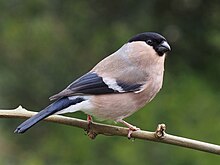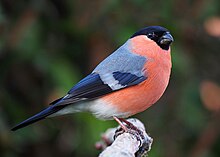
Back Vinkagtiges Afrikaans Finken ALS شرشوريات Arabic شرشوريات ARZ Fringillidae AST Nyema (Fringillidae) AVK Vüroklar Azerbaijani فرینقیللیده AZB Алаҡас турғайҙар Bashkir Уюрковыя Byelorussian
| Finch | |
|---|---|

| |

| |
| Eurasian bullfinch (female above, male below) | |
| Scientific classification | |
| Domain: | Eukaryota |
| Kingdom: | Animalia |
| Phylum: | Chordata |
| Class: | Aves |
| Order: | Passeriformes |
| Superfamily: | Passeroidea |
| Family: | Fringillidae Leach, 1819 |
| Type genus | |
| Fringilla Linnaeus, 1758
| |
| Subfamilies | |
The true finches are small to medium-sized passerine birds in the family Fringillidae. Finches generally have stout conical bills adapted for eating seeds and nuts and often have colourful plumage. They occupy a great range of habitats where they are usually resident and do not migrate. They have a worldwide native distribution except for Australia and the polar regions. The family Fringillidae contains more than two hundred species divided into fifty genera. It includes the canaries, siskins, redpolls, serins, grosbeaks and euphonias, as well as the morphologically divergent Hawaiian honeycreepers.
Many birds in other families are also commonly called "finches". These groups include the estrildid finches (Estrildidae) of the Old World tropics and Australia; some members of the Old World bunting family (Emberizidae) and the New World sparrow family (Passerellidae); and the Darwin's finches of the Galapagos islands, now considered members of the tanager family (Thraupidae).[1]
Finches and canaries were used in the UK, US and Canada in the coal mining industry to detect carbon monoxide from the eighteenth to twentieth century. This practice ceased in the UK in 1986.[2]
- ^ Newton (1973), Clement et al. (1993)
- ^ Eschener, Kat (30 December 2016). "The Story of the Real Canary in the Coal Mine". Smithsonian. Retrieved 11 June 2018.
© MMXXIII Rich X Search. We shall prevail. All rights reserved. Rich X Search